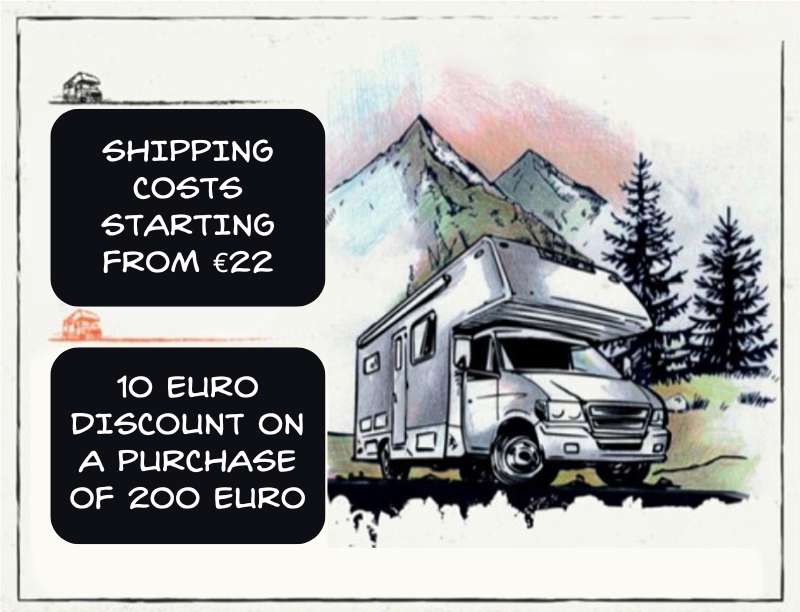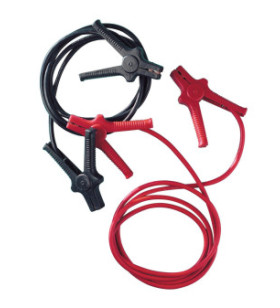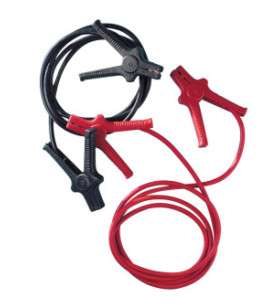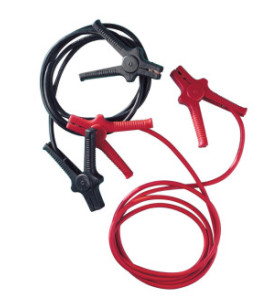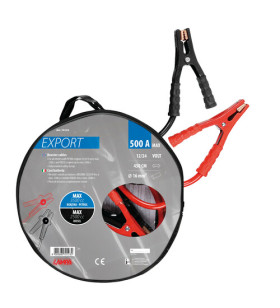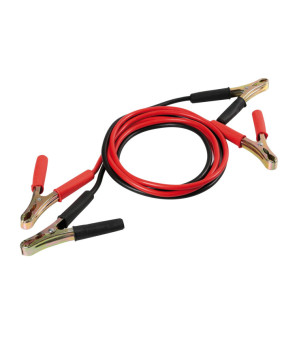




Rif: 9721
Hardened steel spring clamps for a secure grip on battery terminals.
Complete with practical bag/case
TIPS FOR USE
1. Before connecting the vehicles, consult the use and maintenance manual.
2. Make sure both batteries have the same Voltage. Amperage does not matter.
3. Consult the instruction manuals of the two vehicles before starting the connection between the two batteries.
4. Lead-acid batteries contain explosive acid and gases.
5. Avoid any contact with skin, eyes and clothing. Do not create sparks, smoke or light flames near the battery. Wear protective gloves and glasses.
6. Do not start the engine if there is no acid inside the battery or it is frozen. (The acid freezes at -10°C)
7. Make sure that the capacity of the cables is sufficient for the engine capacity of the vehicle to be rescued. (If the capacity of the cables is less, they may overheat and be damaged)
INSTRUCTIONS:
1. Start the engine of the rescue vehicle.
2. Take the red clamps one in each hand and first connect one to the positive (+) pole of the flat battery, then the other to the positive (+) pole of the backup battery.
be careful not to touch any other metal parts of the cars.
3. Take the black clamps one in each hand and first connect one to the negative pole (-) of the backup battery and then the other to a metal part of the engine block in the
vehicle broken down. It is not advisable (although possible) to connect both black clamps to the negative poles (-) of the two batteries.
4. Once the connection is complete, move away from the cables and batteries and then proceed to start the disabled vehicle.
5. While trying to start the disabled car, it is advisable to increase the engine speed of the rescue vehicle to ensure greater current availability.
6. If the disabled vehicle does not start within 10-15 seconds, wait approximately one minute before attempting to start it again. If after repeated attempts the emergency start
If you are unable to start the broken down vehicle, we recommend that you contact a mechanic or an auto electrician as the failure to start is not attributable to the battery but
to another electrical or mechanical failure.
7. Once started, leave the engine running and immediately remove all the clamps in opposite order (see point 3 and 2) first the black clamps from the negative poles (-) and then
the red ones from the positive (+) poles, taking care again not to touch the negative poles or other metal parts of the vehicle. Store the battery cables inside their storage bag.
 DISCOUNT - MAKE A PURCHASE OF AT LEAST €200
DISCOUNT - MAKE A PURCHASE OF AT LEAST €200
You will immediately get a €10 discount
 ITALY - SHIPPING POLICIES
ITALY - SHIPPING POLICIES
Shipping starting from € 8.90 up to 2 kg and not bulky (sum three sides not exceeding one meter)
 UK - MIN ORDER £135 EXCL. SHIPPING
UK - MIN ORDER £135 EXCL. SHIPPING
Customs duties and taxes are the customer's responsibility.
 EUROPE - SHIPPING POLICIES
EUROPE - SHIPPING POLICIES
Shipping from €14,90 up to 2 kg and not bulky (sum 3 sides over a meter). Superiors ask quote.

Hardened steel spring clamps for a secure grip on battery terminals.
Complete with practical bag/case
TIPS FOR USE
1. Before connecting the vehicles, consult the use and maintenance manual.
2. Make sure both batteries have the same Voltage. Amperage does not matter.
3. Consult the instruction manuals of the two vehicles before starting the connection between the two batteries.
4. Lead-acid batteries contain explosive acid and gases.
5. Avoid any contact with skin, eyes and clothing. Do not create sparks, smoke or light flames near the battery. Wear protective gloves and glasses.
6. Do not start the engine if there is no acid inside the battery or it is frozen. (The acid freezes at -10°C)
7. Make sure that the capacity of the cables is sufficient for the engine capacity of the vehicle to be rescued. (If the capacity of the cables is less, they may overheat and be damaged)
INSTRUCTIONS:
1. Start the engine of the rescue vehicle.
2. Take the red clamps one in each hand and first connect one to the positive (+) pole of the flat battery, then the other to the positive (+) pole of the backup battery.
be careful not to touch any other metal parts of the cars.
3. Take the black clamps one in each hand and first connect one to the negative pole (-) of the backup battery and then the other to a metal part of the engine block in the
vehicle broken down. It is not advisable (although possible) to connect both black clamps to the negative poles (-) of the two batteries.
4. Once the connection is complete, move away from the cables and batteries and then proceed to start the disabled vehicle.
5. While trying to start the disabled car, it is advisable to increase the engine speed of the rescue vehicle to ensure greater current availability.
6. If the disabled vehicle does not start within 10-15 seconds, wait approximately one minute before attempting to start it again. If after repeated attempts the emergency start
If you are unable to start the broken down vehicle, we recommend that you contact a mechanic or an auto electrician as the failure to start is not attributable to the battery but
to another electrical or mechanical failure.
7. Once started, leave the engine running and immediately remove all the clamps in opposite order (see point 3 and 2) first the black clamps from the negative poles (-) and then
the red ones from the positive (+) poles, taking care again not to touch the negative poles or other metal parts of the vehicle. Store the battery cables inside their storage bag.
